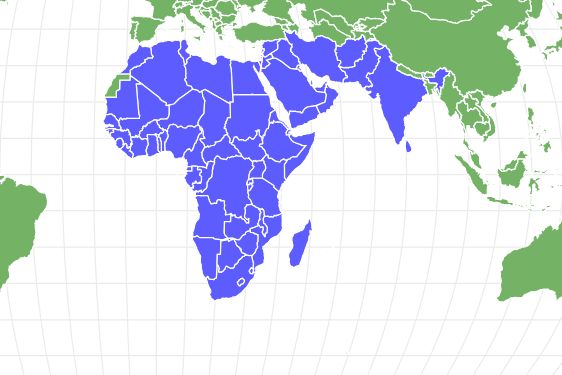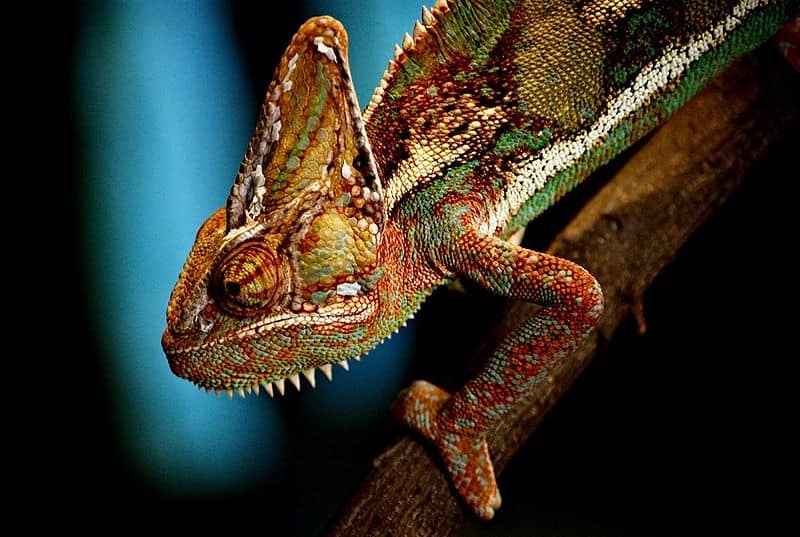Chameleon
Chamaeleonidae
There are more than 160 different species!
Advertisement
Chameleon Scientific Classification
- Kingdom
- Animalia
- Phylum
- Chordata
- Class
- Reptilia
- Order
- Squamata
- Family
- Chamaeleonidae
- Scientific Name
- Chamaeleonidae
Read our Complete Guide to Classification of Animals.
Chameleon Conservation Status
Chameleon Facts
- Main Prey
- Insects, Snails, Leaves
- Distinctive Feature
- Exceptional vision and ability to change skin colour
- Habitat
- Tropical forests and desert
- Diet
- Omnivore
- Lifestyle
- Solitary
- Favorite Food
- Insects
- Type
- Reptile
- Average Clutch Size
- 20
- Slogan
- There are more than 160 different species!
View all of the Chameleon images!
Can change color to pink, red, green, yellow, turquoise, and other colors!
The chameleon, scientific name Chamaeleonidae, is a species of lizard known for their ability to change colors and degrees of brightness. There are over 160 species of chameleon spread across Madagascar, Spain, Africa, Asia, and Portugal. They have large eyes and curled tails, and some species can change the color of their skin to blend in with their surroundings as a defense mechanism from predators. These lizards can change their skin to pink, blue, red, orange, green, black, brown, light blue, yellow, and turquoise.
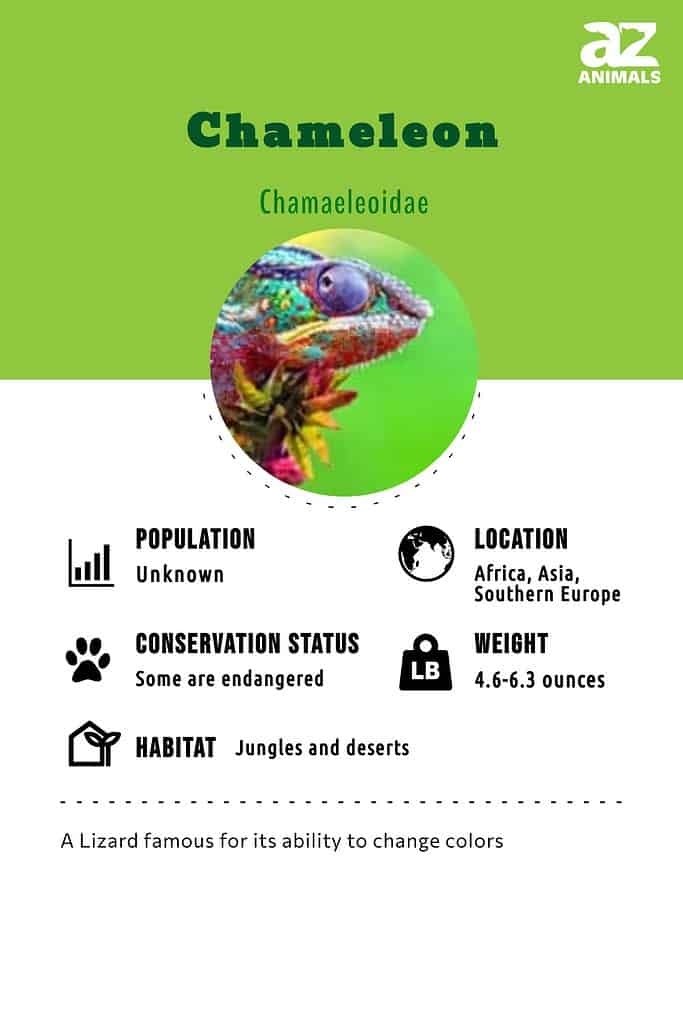
Fun Facts
- The word chameleon comes from the Greek words chamai, which means on the earth, and leon, which means lion. So, the word means earth lion.
- A chameleon can see up to 32 feet in front of them. This makes it even easier to spot crickets, snails, and other types of prey. They also have complete 360-degree vision around their body! This special adaptation allows them to hunt prey and spot predators more effectively.
- Though chameleons have excellent eyesight, they can’t hear very well. Like snakes, they can hear sounds at certain frequencies but depend on their eyesight to catch insects.
Scientific Name
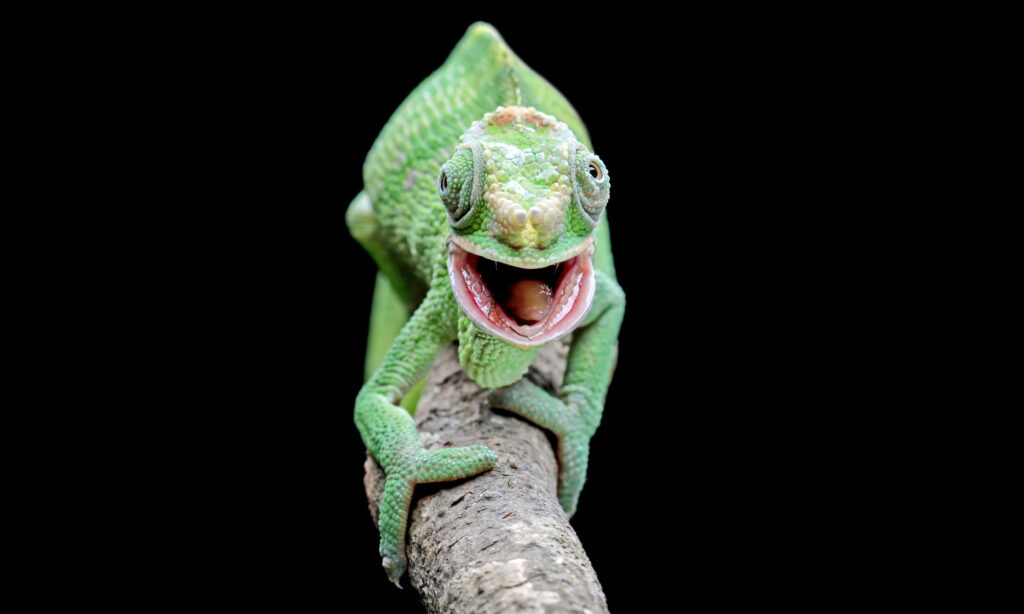
The word chameleon means earth lion!
©Agus_Gatam/Shutterstock.com
The scientific name for a chameleon is Chamaeleo, which is derived from the Greek word “chamai” meaning on the ground and “leōn” meaning lion. This genus of lizards contains over 160 species that are native to Africa, Madagascar, Southern Europe, and Asia. They are known for their ability to change colors with their environment, allowing them to blend in perfectly with trees or rocks. Furthermore, they can also move each eye independently of one another to have a larger field of vision.
Appearance
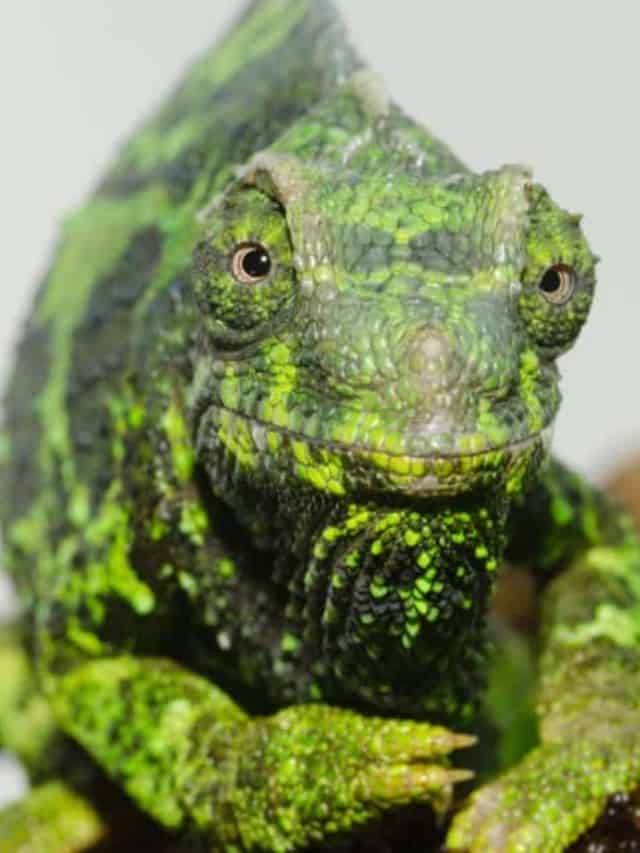
Chameleons can have tongues up to 24 inches long!
©Jason Mintzer/Shutterstock.com
A chameleon is an incredible animal with a unique ability to change its colors and blend into its environment. They come in many shapes, sizes, and colors depending on the species. Generally speaking, most chameleons have flattened bodies and long tails with five digits on each foot that are adapted for gripping branches or other surfaces. Their eyes can move independently of one another which helps them scan their surroundings more efficiently. Chameleons also possess a protruding tongue which they use to capture prey such as insects or small lizards. On average, they range in size from 2 inches up to 24 inches in length! Depending on the species, they usually feature bright hues of green and yellow with various patterns of spots throughout their body making them quite eye-catching reptiles!
Habitat
Chameleons are animals that are found throughout the jungle and desert alike, in Africa, Asia, and parts of Southern Europe, and chameleons have also been introduced to parts of North America. Most of these lizards live in trees or in bushes. Only a few species of chameleon live on the ground under piles of leaves.
Predators
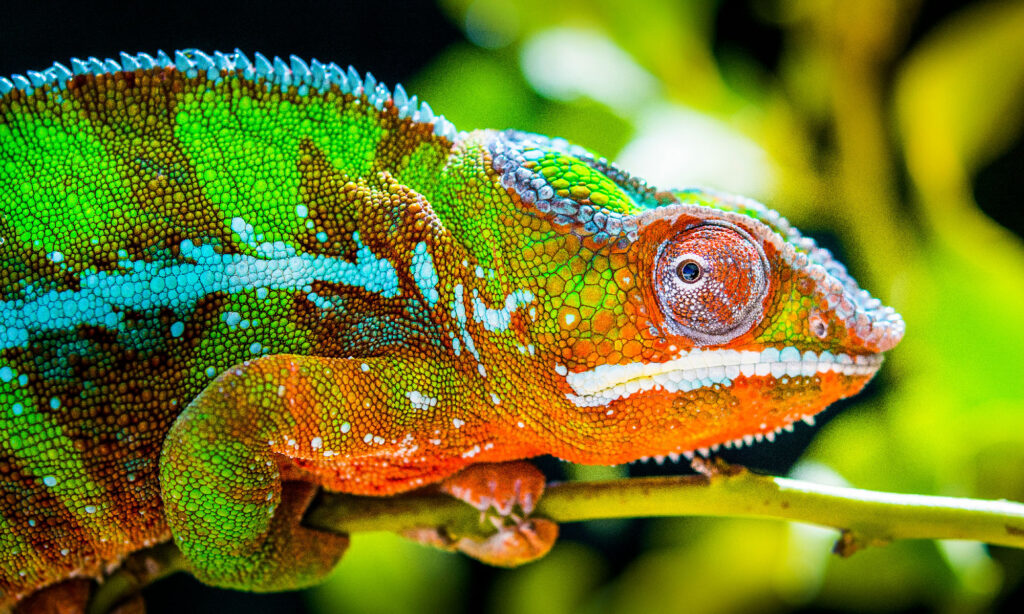
Chameleons use their beautiful colors as a defense mechanism.
©OMP.stock/Shutterstock.com
There are many animals that eat these lizards. In fact, the smaller a chameleon is, the more likely it is to be eaten by a larger animal. Some of the predators include snakes, birds, and sometimes monkeys. Though they can blend in with their environment, they are near the bottom of the food chain. This means there are many animals above them on the food chain that can eat them.
Defense Against Predators
A chameleon’s ability to change color to match its environment is its way of protecting itself when a predator is nearby. If this lizard is on a branch, its skin can turn a color that is very close to the color of the branch. Many predators may pass by without ever seeing the chameleon sitting quietly on the tree branch.
Evolution
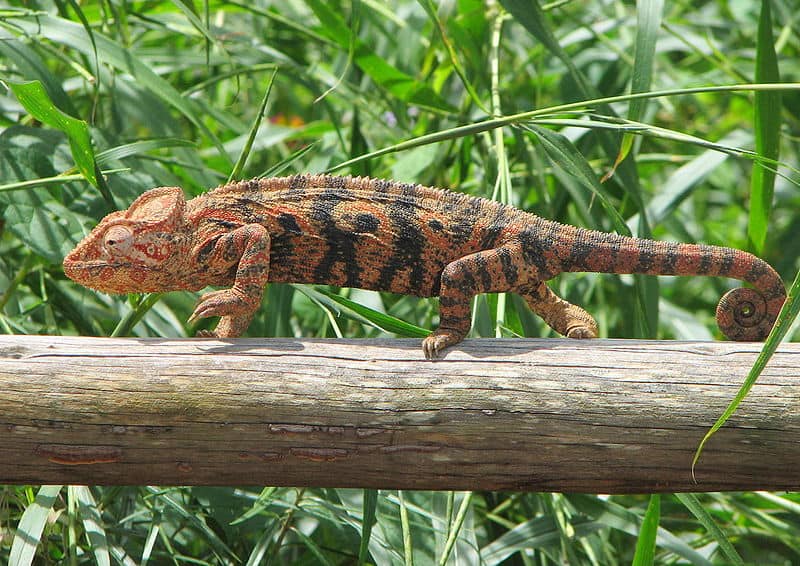
Oustalets Chameleon, Ambalavao, Madagascar
The chameleon is a very unique species of lizard, known for its ability to change color in order to adapt to their environment. It has been around for millions of years and is believed to have descended from the iguanid family. Chameleons are found throughout Africa, Madagascar, parts of southern Europe and Asia, as well as some islands in the Indian Ocean.
The evolution of the chameleon has also enabled it to develop several interesting characteristics that make it uniquely suited to its habitat. They have specialized eyes with 360-degree vision which allows them to see predators from any direction, long tongues so they can catch prey quickly, prehensile tails which help them climb trees more easily, and claws that enable them to grip branches firmly. Additionally, their skin pigmentation allows them to blend into their surroundings almost instantly when threatened by a predator or other animals.
Overall, the incredible evolutionary process behind the chameleon’s remarkable adaptation capabilities is truly amazing!
Behavior
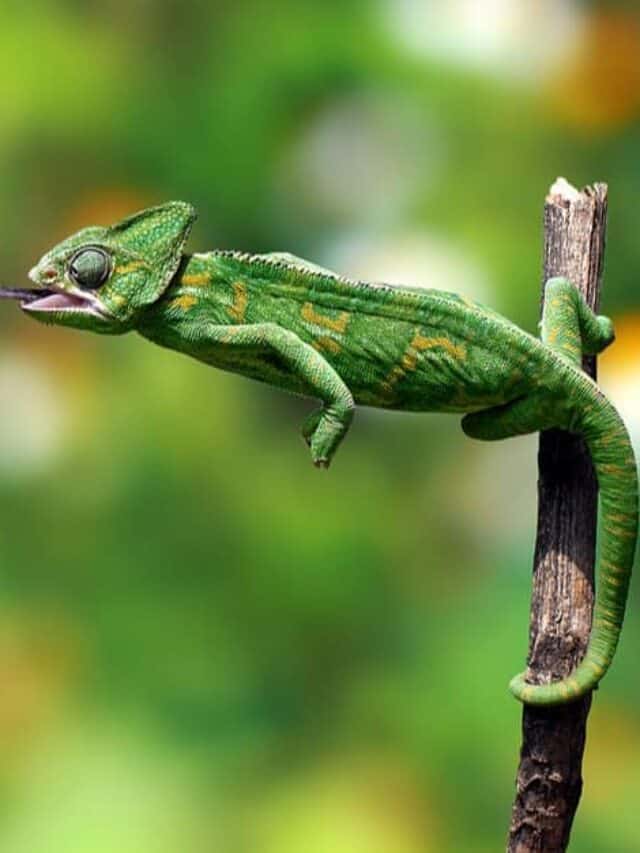
When threatened, Chameleons turn sideways to appear larger.
©Lauren Suryanata/Shutterstock.com
Chameleons are known for their ability to change color, but they also possess many other interesting behaviors. Chameleons are known to be solitary creatures, spending most of their time alone or in pairs. They can often be seen basking in the sun on branches or leaves, and when disturbed they will normally take cover among the foliage. Their long tongues help them catch prey such as insects and small reptiles; they have excellent vision which helps them spot potential food sources from a distance. When threatened by predators, chameleons may puff themselves up to appear larger than normal and give off a hissing sound as a warning sign. In addition to this defensive behavior, some species of chameleon may even fight each other using their tails!
Chameleons are animals that communicate with one another by using their body language. For instance, a chameleon trying to protect its territory from an intruder is likely to turn sideways. This makes the lizard look bigger and more threatening. A chameleon that feels threatened may open its mouth to try to scare another one away.
Reproduction
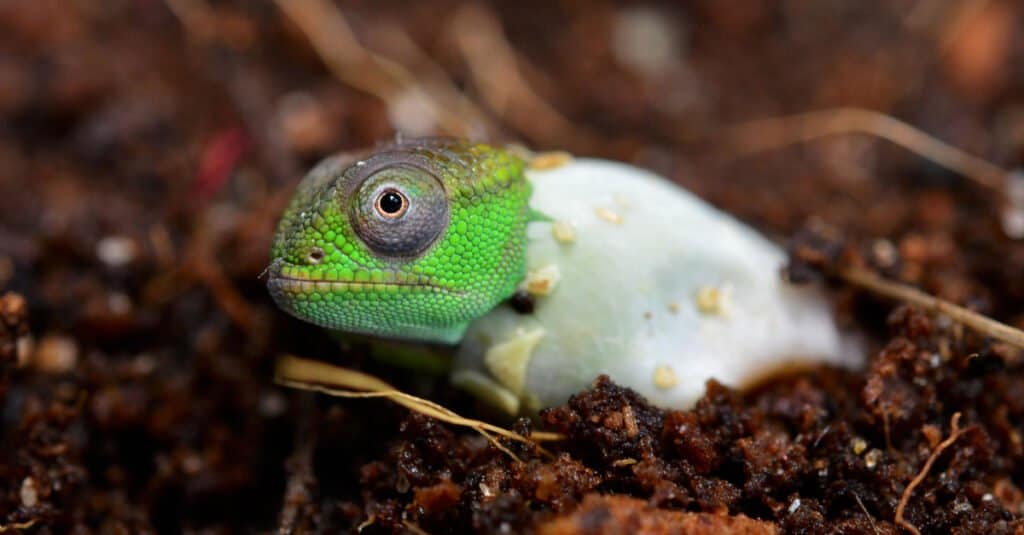
Some chameleons lay eggs, while others have live babies.
©Nick Henn/Shutterstock.com
Most species of these lizards lay eggs, while a few have live babies. The female digs a hole in the ground and lays her eggs inside it to keep them warm. Usually, they lay around 20 eggs, but it can be more or fewer depending on the species. It can take four months to a year for the eggs to hatch. Jackson’s chameleon is one example of a species that have live babies. This lizard can have from 8 to 30 live babies after being pregnant for about six months.
Chameleons, like most other reptiles, reproduce sexually. During courtship and mating rituals, male chameleons will display their bright colors to attract mates. Male chameleons also use head bobbing as a way of flirting and competing with rivals for the attention of females. If a male is successful in both displaying his colors and winning the battle using body language instead of physical contact, he may be chosen by the female for mating purposes.
The gestation period for chameleon eggs ranges anywhere from one month to several months depending on species and environmental factors such as temperature or humidity levels. After hatching from eggs laid in nests underground or in trees or bushes, baby chameleons are born without parental care; they must fend for themselves after birth.
The lifespan of a chameleon depends on its species but generally ranges from five to fifteen years when kept in captivity with optimal conditions such as proper diet and environment being met regularly. Wild-living chameleons tend to have shorter lifespans due to a lack of food sources, predators, disease exposure, etc., which can drastically reduce their life expectancy if not addressed properly.
Diet
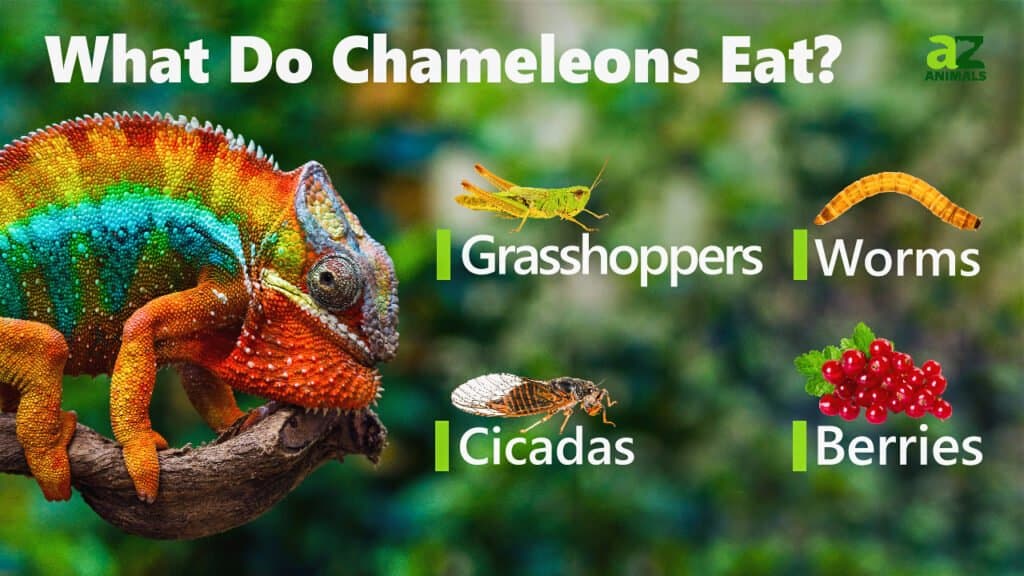
Chameleons eat a diet that’s mostly focused on insects. While chameleons are omnivores that will feed on vegetation such as dandelions and other vegetation, most of their prey is insects such as grasshoppers, crickets, and dragonflies.
For a full list of chameleon diets, give our ‘What Do Chameleons Eat? 16 Foods in their Diet‘ page a read!
Conservation Status

Some chameleon species are endangered due to habitat loss.
©Lauren Suryanata/Shutterstock.com
Chameleons are fascinating creatures that come in a variety of shapes and sizes. Unfortunately, their numbers have been steadily declining due to a number of factors, including habitat destruction and hunting for the pet trade. As a result, several species of chameleon have been listed as endangered or critically endangered on the IUCN Red List. For example, Parson’s Chameleon is classified as Endangered due to its restricted range and continued decline in population size from ongoing habitat loss, poaching for pets, and over-collection by scientists. Another species at risk is the Panther Chameleon which has seen significant declines in Madagascar due to deforestation activities such as burning woodlands for agriculture. Conservation efforts must focus on protecting suitable habitats so these amazing animals can continue to thrive around the world.
120 Types of Chameleons
| 120 Species of Chameleons |
|---|
| African Chameleon – Species: Chamaeleo africanus Laurenti |
| Amber Chameleon – Species: Calumma amber |
| Antsingy Leaf Chameleon – Species: Brookesia perarmata |
| Arabian Chameleon – Species: Chamaeleo arabicus Matschie |
| Bearded Pygmy Chameleon – Species: Rieppeleon brevicaudatus |
| Beraducci’s Pygmy Chameleon – Species: Rhampholeon beraduccii |
| Bizarre-Nosed Chameleon – Species: Calumma hafahafa |
| Black-headed Dwarf Chameleon – Species: Bradypodion melanocephalum |
| Blunt-Nosed Chameleon – Species: Calumma tsycorne |
| Bocage’s Chameleon – Subspecies: Chamaeleo dilepis quilensis |
| Boulenger’s Pygmy Chameleon – Species: Rhampholeon boulengeri |
| Brown Leaf Chameleon – Species: Brookesia superciliaris |
| Cameroon Sailfin Chameleon – Species: Trioceros montium |
| Cameroon Stumptail Chameleon – Species: Rhampholeon spectrum |
| Cape Dwarf Chameleon – Species: Bradypodion pumilum |
| Carpenter’s Chameleon – Species: Kinyongia carpenteri |
| Carpet Chameleon – Species: Furcifer lateralis |
| Carpet Chameleon – Species: Furcifer major |
| Chameleon Dragon – Species: Chelosania brunnea |
| Chameleon Forest Dragon – Species: Gonocephalus chamaeleontinus |
| Chapmans’ Pygmy Chameleon – Species: Rhampholeon chapmanorum |
| Circular-scaled Chameleon – Species: Kinyongia gyrolepis |
| Coarse Chameleon – Species: Trioceros rudis |
| Cone-headed Chameleon – Species: Chamaeleo calyptratus |
| Crested Chameleon – Species: Trioceros cristatus |
| Cryptic Chameleon – Species: Calumma crypticum |
| Dhlinza Dwarf Chameleon – Species: Bradypodion caeruleogula |
| Domergue’s Leaf Chameleon – Species: Brookesia thieli |
| Double-scaled Chameleon – Species: Chamaeleo anchietae |
| Drakensberg Dwarf Chameleon – Species: Bradypodion dracomontanum |
| Eiongate Leaf Chameleon – Species: Palleon nasus |
| Eisentraut’s Chameleon – Subspecies: Trioceros quadricornis eisentrauti |
| Eshowe Dwarf Chameleon – Species: Bradypodion caeruleogula |
| Fito Leaf Chameleon – Species: Brookesia lambertoni |
| Flap-neck Chameleon – Species: Chamaeleo dilepis |
| Flapneck Chameleon – Species: Chamaeleo dilepis |
| Four-horned Chameleon – Species: Trioceros quadricornis |
| Graceful Chameleon – Species: Chamaeleo gracilis |
| Gray Chameleon – Species: Trioceros chapini |
| Green Pygmy Chameleon – Species: Rhampholeon viridis |
| High-casqued Chameleon – Species: Trioceros hoehnelii |
| Iaraka River Leaf Chameleon – Species: Brookesia vadoni |
| Ilolo Chameleon – Species: Trioceros goetzei |
| Indian Chameleon – Species: Chamaeleo zeylanicus |
| Ituri Chameleon – Species: Kinyongia adolfifriderici |
| Jackson’s Chameleon – Species: Chamaeleo jacksonii |
| Jackson’s Chameleon – Species: Trioceros jacksonii |
| Johnston’s Chameleon – Species: Trioceros johnstoni |
| Karoo Dwarf Chameleon – Species: Bradypodion karrooicum |
| Kentani Dwarf Chameleon – Species: Bradypodion kentanicum |
| Kenya Stumptail Chameleon – Species: Rieppeleon kerstenii |
| Knysna Dwarf Chameleon – Species: Bradypodion damaranum |
| Labord’s Chameleon – Species: Furcifer labordi |
| Lesser Chameleon – Species: Furcifer minor |
| Magombera Chameleon – Species: Kinyongia magomberae |
| Malawi Stumptail Chameleon – Species: Rhampholeon platyceps |
| Marojejy Leaf Chameleon – Species: Brookesia griveaudi |
| Marojejy Peak Chameleon – Species: Calumma jejy |
| Marshall’s Stumptail Chameleon – Species: Rhampholeon marshalli |
| Matschie’s Dwarf Chameleon – Species: Kinyongia tenuis |
| Meller’s Chameleon – Species: Trioceros melleri |
| Minute Leaf Chameleon – Species: Brookesia minima |
| Montane Side-striped Chameleon – Species: Trioceros ellioti |
| Mount Chiperone Pygmy Chameleon – Species: Rhampholeon nebulauctor |
| Mount d’Ambre Leaf Chameleon – Species: Brookesia tuberculata |
| Mount Inago Pygmy Chameleon – Species: Rhampholeon bruessoworum |
| Mount Kulal Chameleon – Species: Trioceros narraioca |
| Mount Lefo Chameleon – Species: Trioceros wiedersheimi |
| Mount Mabu Pygmy Chameleon – Species: Rhampholeon maspictus |
| Mount Mulanje Pygmy Chameleon – Species: Rhampholeon platyceps |
| Mount Namuli Pygmy Chameleon – Species: Rhampholeon tilburyi |
| Mount-Nyiro Bearded Chameleon – Species: Kinyongia asheorum |
| Moyer’s Pygmy Chameleon – Species: Rhampholeon moyeri |
| Mt Kenya Hornless Chameleon – Species: Kinyongia excubitor |
| Mt Kenya Side-striped Chameleon – Species: Trioceros schubotzi |
| Mt Nyiru Chameleon – Species: Trioceros ntunte |
| Namaqua Chameleon – Species: Chamaeleo namaquensis |
| Natal Midlands Dwarf Chameleon – Species: Bradypodion thamnobates |
| Ngome Dwarf Chameleon – Species: Bradypodion ngomeense |
| Ngosi Volcano Chameleon – Species: Trioceros fuelleborni |
| Nguru Pygmy Chameleon – Species: Rhampholeon acuminatus |
| Northem Leaf Chameleon – Species: Brookesia ebenaui |
| Owen’s Chameleon – Species: Trioceros oweni |
| Parson’s Chameleon – Species: Calumma parsonii |
| Peltiers’ Chameleon – Species: Calumma peltierorum |
| Permet Leaf Chameleon – Species: Brookesia therezieni |
| Perret’s Chameleon – Species: Trioceros perreti |
| Pfeffer’s Chameleon – Species: Trioceros pfefferi |
| Plated Leaf Chameleon – Species: Brookesia stumpffi |
| Qudeni Dwarf Chameleon – Species: Bradypodion nemorale |
| Rednose Dwarf Chameleon – Species: Kinyongia oxyrhina |
| Robertson’s Dwarf Chameleon – Species: Bradypodion gutturale |
| Rosette-nosed Pygmy Chameleon – Species: Rhampholeon spinosus |
| Ruppell’s Desert Chameleon – Species: Trioceros affinis |
| Ruwenzori Side-striped Chameleon – Species: Trioceros rudis |
| Senegal Chameleon – Species: Chamaeleo senegalensis |
| Setaro’s Dwarf Chameleon – Species: Bradypodion setaroi |
| Smith’s Dwarf Chameleon – Species: Bradypodion taeniabronchum |
| Smooth Chameleon – Species: Chamaeleo laevigatus |
| Socotra Chameleon – Species: Chamaeleo monachus |
| South African Stumptail Chameleon – Species: Rhampholeon nchisiensis |
| Southern Dwarf Chameleon – Species: Bradypodion ventrale |
| Spiny Leaf Chameleon – Species: Brookesia decaryi |
| Spiny-flanked Chameleon – Species: Trioceros laterispinis |
| Strange-horned Chameleon – Species: Kinyongia xenorhina |
| Tanzania Mountain Chameleon – Species: Trioceros tempeli |
| Tilbury’s Chameleon – Species: Trioceros marsabitensis |
| Toothed Leaf Chameleon – Species: Brookesia dentata |
| Transkei Dwarf Chameleon – Species: Bradypodion caffer |
| Transvaal Dwarf Chameleon – Species: Bradypodion transvaalense |
| Two-lined Chameleon – Species: Trioceros bitaeniatus |
| Ukinga Hornless Chameleon – Species: Trioceros incornutus |
| Uluguru Pygmy Chameleon – Species: Rhampholeon uluguruensis |
| Usambara Soft-horned Chameleon – Species: Kinyongia tenuis |
| Usambara Stumptail Chameleon – Species: Rhampholeon temporalis |
| Uthmöller’s Chameleon – Species: Kinyongia uthmoelleri |
| Veiled Chameleon – Species: Chamaeleo calyptratus |
| Wavy Chameleon – Species: Trioceros deremensis |
| Wemer’s Chameleon – Species: Trioceros werneri |
| Yemen Chameleon – Species: Chamaeleo calyptratus |
| Zululand Dwarf Chameleon – Species: Bradypodion nemorale |
Chameleon FAQs (Frequently Asked Questions)
What are the Differences Between Iguanas and Chameleons?
Chameleons and iguanas have several key differences. First, they come from different areas of the world. Iguanas are from the Americas while chameleons are from Africa and Asia. Second, they have key anatomical differences like their tails and eyes. Chameleon eyes protrude and can view different directions while iguana eyes are more typical of reptiles.
What Do Chameleons Look Like?
Chameleons have five toes on each of their four feet. These toes help them to climb trees so they can sit in the highest branches. A chameleon’s five toes work kind of like a human’s thumb and fingers. Chameleons also have a tail that can wrap around a tree branch helping them to climb without falling. This reptile has the ability to change the color of its scaly skin. Some chameleons can display bright reds and yellows while others can turn green, black, brown or gray. A chameleon’s color can change with its emotions. It can turn one color when it’s angry and another when its afraid. A chameleon’s range of colors depends a lot on its species. This reptile has a long tongue with a sticky surface used for catching its food. Also, it has eyes that can move in separate directions. This allows a chameleon to see all around it.
What Does a Chameleon Eat?
The chameleon is generally an omnivorous animal, although some chameleon species are known to have a more carnivorous diet, and other chameleon species prefer to be vegetarians. A chameleon will generally eat anything though including berries, leaves, fruits, insects, worms, snails and some of the larger chameleon species will also hunt small reptiles. A chameleon that eats insects uses its long, sticky tongue to grab the locusts, grasshoppers, snails and crickets they see. Since many chameleons move very slowly, their long tongue can get them something to eat without needing to chase it. Once the insect goes into a chameleon’s mouth, it is crushed by the reptile’s powerful jaws. Larger varieties of chameleons have been known to eat small birds.
Does a Chameleon Drink A Lot of Water?
A chameleon doesn’t drink a large amount of water but does need constant access to it. A chameleon living in a forest drinks drips of water off the leaves of trees after a rainstorm. Most chameleons look for dripping water instead of looking for a pool on the forest floor.
How Big Are Chameleons?
The size of a chameleon depends on its species. A Malagasy giant chameleon measures about 27 inches while the Leaf chameleon is only a half inch long. Both of these chameleons live in Madagascar. While some chameleon species weigh less than a pound, others can weigh two to four pounds. The Parson’s chameleon is about the size of a house cat!
How Long Do Chameleons Live?
In the wild, chameleons can live for about four to eight years. Chameleons that are cared for in a zoo can live up to ten years.
Do Chameleons Make Any Sounds?
Chameleons do make sound. Many species make a hissing sound if they are angry or feel threatened by something in their environment.
Do Chameleons Live in Groups?
Chameleons do not live in groups. They prefer to sit alone in the trees and in bushes. Chameleons do get together in order to mate, but otherwise they are known as solitary animals.
Do Chameleons Make Good Pets?
Although many types of chameleons are sold in pet shops, they don’t make the best pets. These reptiles require a certain environment to enjoy a healthy life. It’s hard to create an environment like that in an aquarium. Plus, they need a special diet to remain healthy.
Do Chameleons Shed Their Skin?
Chameleons shed their skin like snakes and other reptiles. But, while a snake sheds its skin in one long piece, a chameleon sheds its skin in small sections. A chameleon may shed its skin once a month or once every few months, depending on its species. Along with shedding its skin naturally, a chameleon may shed because it is feeling stressed or it is sick.
What Kingdom do Chameleons belong to?
Chameleons belong to the Kingdom Animalia.
What phylum do Chameleons belong to?
Chameleons belong to the phylum Chordata.
What class do Chameleons belong to?
Chameleons belong to the class Reptilia.
What family do Chameleons belong to?
Chameleons belong to the family Chamaeleonidae.
What order do Chameleons belong to?
Chameleons belong to the order Squamata.
What type of covering do Chameleons have?
Chameleons are covered in Scales.
In what type of habitat do Chameleons live?
Chameleons live in tropical forests and deserts.
What are some distinguishing features of Chameleons?
Chameleons have exceptional vision and the ability to change their skin color.
What are some predators of Chameleons?
Predators of Chameleons include snakes, birds, and mammals.
What is the average clutch size of a Chameleon?
Chameleons typically lay 20 eggs.
What is an interesting fact about Chameleons?
There are more than 160 different species of Chameleon!
What is the scientific name for the Chameleon?
The scientific name for the Chameleon is Chamaeleonidae.
How fast is a Chameleon?
A Chameleon can travel at speeds of up to 21 miles per hour.
What is the difference between a bearded dragon and a chameleon?
The greatest differences between a bearded dragon and chameleon are their size, tails, and eyes. Bearded dragons are smaller than chameleons. Although they share a similar body length, most of a bearded dragon’s body length comes from their somewhat thin tails. Chameleons also weigh more than bearded dragons, but they can be incredibly small, too.
What's the difference between chameleons and lizards?
The greatest differences between a chameleon and a lizard are their tails, eyes, and tongues. Chameleons are known for their unique prehensile tails, and they are one of the few reptiles that possess them.
How to say Chameleon in ...
Thank you for reading! Have some feedback for us? Contact the AZ Animals editorial team.
Sources
- David Burnie, Dorling Kindersley (2011) Animal, The Definitive Visual Guide To The World's Wildlife
- Tom Jackson, Lorenz Books (2007) The World Encyclopedia Of Animals
- David Burnie, Kingfisher (2011) The Kingfisher Animal Encyclopedia
- Richard Mackay, University of California Press (2009) The Atlas Of Endangered Species
- David Burnie, Dorling Kindersley (2008) Illustrated Encyclopedia Of Animals
- Dorling Kindersley (2006) Dorling Kindersley Encyclopedia Of Animals

